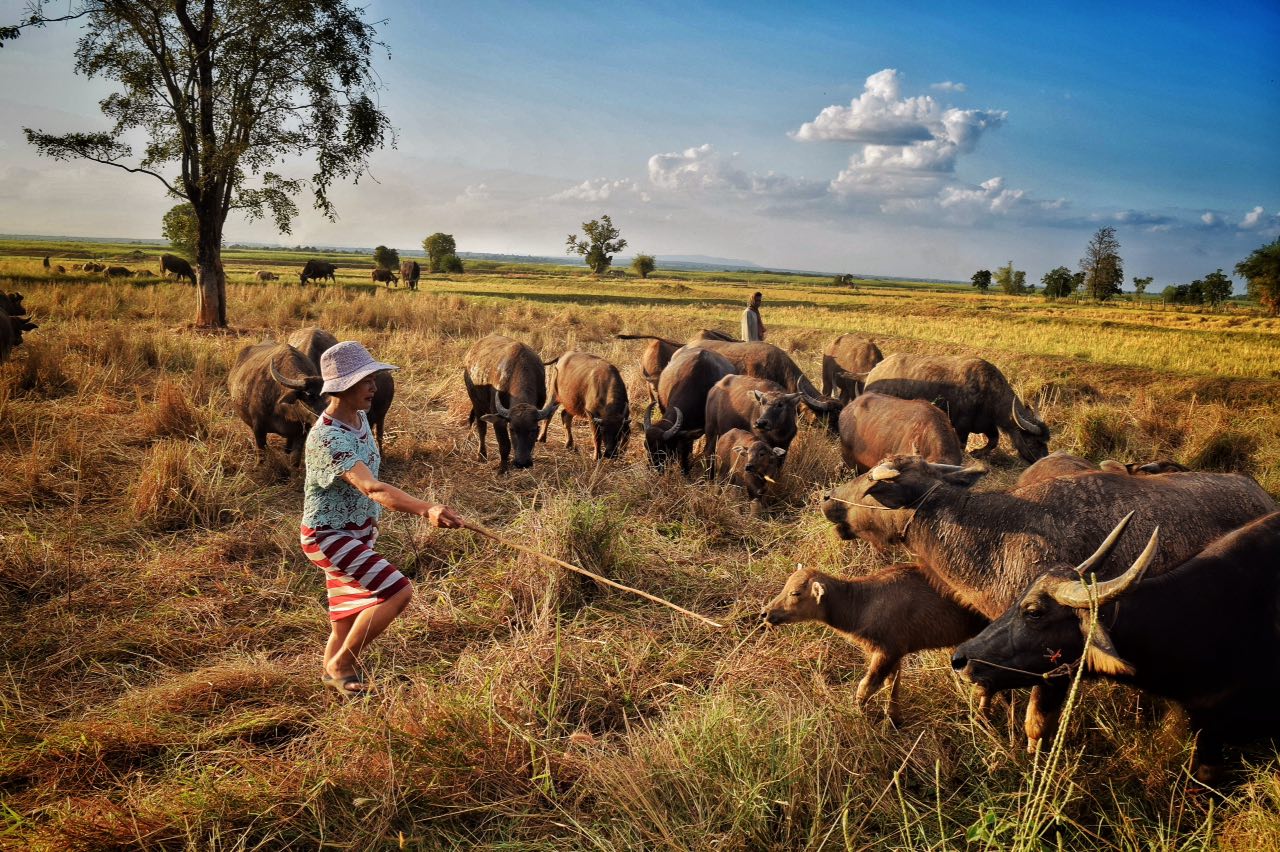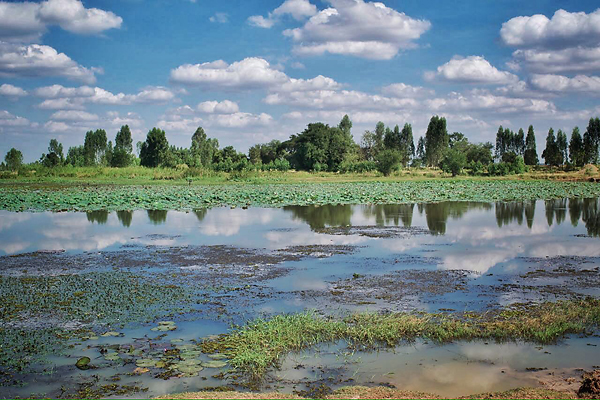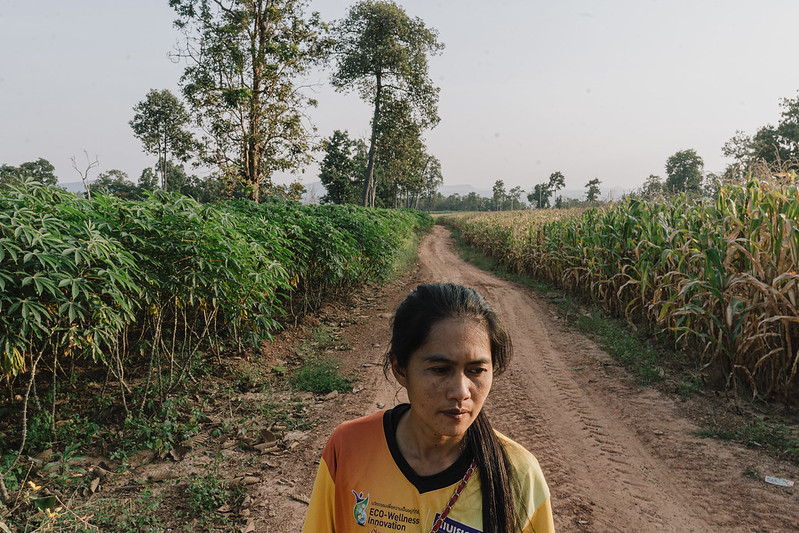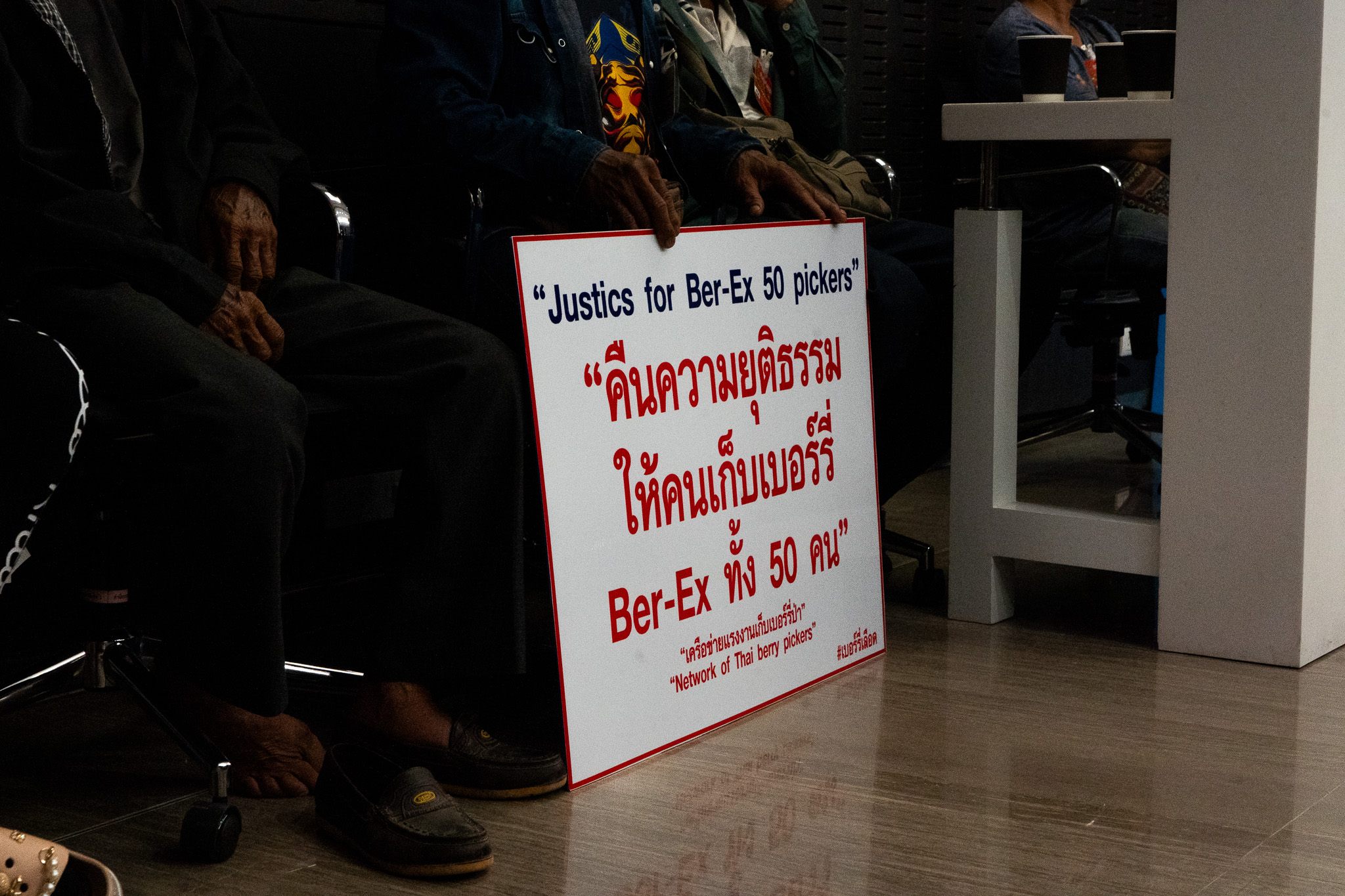Villagers around Kaeng Lawa Lake in Khon Kaen Province make a good living from raising and selling water buffalo and the fertilizer from their manure. But development projects proposed by business investors and the Royal Irrigation Department threaten to destroy the wetlands that the villagers and buffalo depend on.
Guest contribution by Jamie Rudd

There are currently 1,689 water buffalo in the Kaeng Lawa wetland, providing steady income for 116 households. However, according to the Department of Livestock Development, the number of buffalo has decreased 18% per year nationally.
The sunlight began to turn golden over the Kaeng Lawa wetlands in Khon Kaen Province, and Bunchuay Inthong set out on her nightly journey to retrieve her water buffalo. She donned a wide-brimmed hat to keep the rays of the descending sun from her eyes and grasped the hand of her young niece, “Nam Cow,” as they made their way to the wetland pasture.
A number of their neighbors were already there, using small sticks and strong voices to coax the large community herd of water buffalo into their smaller family clusters. Ms. Bunchuay joined them, laughing as several of the young calves ran around her, searching for their mothers. Eventually, her group solidified – a troop of 15 in the large convoy of livestock heading home for the evening.
In Ba Daeng village, many people have made a comfortable living by raising buffalo, but recently there is growing concern that development projects will infringe on the buffalos’ wetland habitat, making their way of life impossible.
Changing Face of the Wetlands
The Kaeng Lawa Lake wetlands are a natural habitat for water buffalo that provides the animals with plenty of plants to eat and marshes to bathe in, making buffalo-raising a fairly hands-off job.
Villagers say the importance of this ecosystem is often overlooked by those who view the lake as a potential source of profit, or a quick fix to water scarcity – namely, business investors and government agencies that have proposed major projects in the area in recent years.
The wetlands have already undergone significant damage from water management projects headed by the Royal Irrigation Department (RID). In the 1970s the RID identified Kaeng Lawa Lake as a good source of water for the nearby city of Ban Phai, and converted the lake into a reservoir. This interference severely altered the landscape, causing unnaturally long periods of flooding in the area, Ba Daeng residents say.
This forced many buffalo raisers to keep their herds on plots of land and rice fields at home – rather than by the lake – for several months a year during the rainy season, where they must closely monitor the buffalo and supply them with food and water that is normally provided by the wetlands.
As a result, the number of buffalo these individual villagers can raise is limited by the amount of land they own and whether they are capable – economically and physically – of caring for the animals for three continuous months.

Wetlands are critical ecosystems that support a wide variety of vegetation and wildlife. They are one of the fastest disappearing environments in the world and today make up only 7.5% of Thailand’s landmass.
Buffalo Raising: Livelihoods in the Wetlands
Back at the house, 50-year-old Ms. Bunchuay locked the gate to the pen she keeps her herd in overnight. In the morning she will return to lead her buffalo back to the fields. This has been her routine for the past 18 years – a quiet way of life that has allowed for harmonious coexistence of buffalo, human, and land alike.
“It’s a pretty easy lifestyle,” she said, “With cows, you have to feed them and tie them to something so they don’t wander away. But buffalo are different; you can just let them go.”
Ms. Bunchuay noted that one of the biggest advantages of raising buffalo – besides the reliable profits villagers can earn from selling them – is that it allows them time for additional financial pursuits, like weaving, rice farming, and fishing.
“We make around 120,000 baht a year from selling buffalo and compost from their manure,” Ms. Bunchuay said. “This, in addition to the 50-60,000 baht we make from selling our rice and my husband’s salary as headman, allows us to comfortably handle our expenses. We can afford to pay for insurance and our daughter’s college tuition, and we don’t have any debt with the BAAC (Bank for Agriculture and Agricultural Cooperatives).”
Like many in the village, Ms. Bunchuay learned how to raise buffalo from her parents. Her livelihood depends on water buffalo in much the same way that farmers have depended on the animals for centuries to plow their fields and fertilize the soil with their manure. While the advent of modern agricultural technology has made buffalo labor superfluous, a large market for buffalo products, including their meat and the natural compost they produce, has emerged. A single bag of manure can be sold for 35 baht, and an adult buffalo can fetch as much as 60,000 baht.
Villagers around Kaeng Lawa can earn over 400-500 baht a day from manure sales and say that customers come from as far as the south of Thailand to buy fertilizer in bulk.
Buffalo and beef meat consumption domestically is fairly low – a Khon Kaen University study reports that per capita consumption is only 0.86 kg per head per year – but neighboring countries have a great demand for both buffalo meat and breeding buffalo, the Thailand Buffalo Strategic Plan 2012-2016 reports.
Thai water buffaloes are exported for slaughter to other Southeast Asian nations and Hong Kong. The Food and Agriculture Organization (FAO) estimates that buffalo and beef exports garnered $4,5 million in 2002. Buffalo are also used to produce milk, cheese, and leather.
Buffalo raisers foster herds ranging in size from around 10 to nearly 100 animals. Most start small, allowing their herds to grow over time – an easy enough task, as water buffalo are fairly self-sufficient. Female buffalo usually give birth to two calves in three years without the need for artificial insemination.
Challenging Enduring Stereotypes
Despite the profits and the relatively undemanding nature of the trade, buffalo-raising is not a popular profession nationally. According to the Thailand Buffalo Strategic Plan 2012-2015, in 2011 there were only 271, 112 buffalo-raising families in the country, a significant decrease from the 451,283 households in 2002.
The majority of these buffalo-raising families – 228, 842 or 84% – live in the Northeast, the region where farming is most predominant. This close link between Isaan and buffalo-raising likely plays into the national stereotype that the culture of Isaan is “backwards” and that its people are “as stupid as a buffalo” – a common Thai insult.
In addition to the phase-out of buffalo in farming, villagers suspect that the stigma surrounding the livelihood may be connected to the decline in buffalo-raising.
“Our ancestors raised buffalo, but now our children go to college and don’t want to continue the practice,” said 56-year-old Chanda Singna, a Ba Daeng local. “They believe that raising buffalo is something only people that can’t succeed academically or professionally do.”
According to Ms. Chanda, this perspective is shared by Thailand’s urban population and the broader public, which perpetuates the notion that buffalo-raisers and farmers are uneducated and unsuccessful. Yet, those that continue the practice argue that their way of life is both culturally and financially valuable.
“Having buffalo is like having credit,” Ms. Bunchuay said. “Banks are much more willing to give loans to people who own buffalo because they know they’ll be able to pay them back.”
And for those with larger herds, loans are rarely necessary. When big expenses come up, buffalo-raisers usually sell a portion of their herd to cover the costs. Many long-term buffalo raisers find that the trade enables them to send their kids to university and even retire on the profits from selling their herds.
Somwang Khonchai is one such retiree. The 63-year-old woman has been raising buffalo her entire life, but decided to sell her herd last year to have more time for her grandchildren. For now, she is content to live off of the 360,000 baht she got for her small herd and is happy that she sold them to someone in her community, comforted knowing that her former livestock are never far away.
“I was very sad to sell the buffalo,” Ms. Somwang said. “I cried a lot. Raising buffalo is what allowed me to support my family on my own. My husband died when I was 34 but I was still able to take care of my kids and build a big house using money from the buffalo. It’s a very sustainable occupation and an occupation that I loved.”
Buffalo raisers in Ba Daeng praise the benefits of the trade. They see it as a rewarding livelihood that provides a high level of financial security and freedom to those it employs – hardly resembling the negative images of poor, struggling farmers that buffalo-raising is often associated with.
But Ms. Somwang worries that the profession may not be around much longer if certain development projects move forward.
Threatened By Development
The RID currently plans to expand the Kaeng Lawa reservoir by dredging much of the communal land that locals keep their buffalo on. The RID has owned this land since the 1980s when the water management project was completed, but has reluctantly allowed villagers to continue raising their buffalo there for the time being.
The buffalo-raising profession has also been threatened by investors, who have shown significant interest in turning the reservoir and its surrounding areas into a tourist destination. Neither of these plans leaves room for the traditional livelihoods of locals, their buffalo, or the wetland they depend on.
“If the wetland is destroyed, the people here won’t be able to raise buffalo anymore,” said Jarunpis Jantasri, a community organizer in Khon Kaen Province.
Ms. Jarunpis, who has been working as the collaboration coordinator between the Department of Environmental Quality Promotion and the local wetland preservation group, sees the traditional livelihoods the wetland supports as superior to the professions encouraged by new development trends, for instance, jobs in the cash cropping and tourism industries.
Like many Ba Daeng villagers, Ms. Jarunpis argued that these occupations are far less sustainable and profitable than raising buffalo. However, she worries that policy makers will not realize the value of buffalo raising in time to preserve the practice.
Villagers have urged the RID to not dredge the communal land around the lake, which would destroy the habitat buffalo live on and force buffalo-raisers to sell all their buffalo or keep what few they can on their personal land year-round. They are instead requesting that the office grant them the easement rights to the area so that they can raise their animals there legally. But the RID refused, citing concerns that the buffalo-raising community would expand and pollute the lake, making it an undesirable source of water for Ban Phai City.
According to a representative of the Regional Irrigation Office 6 Khon Kaen, who requested not to be named, “the reason villagers can still raise buffalo there is because the RID is also trying to help them. But it is only a verbal agreement, it can’t be done legally.” As the villagers have no official agreement with the RID, they are in danger of losing the land at any time.
For Ms. Bunchuay, this is a terrifying thought. If her community is deprived of the wetlands, she knows that their way of life and their main source of income will be taken with it. Most villagers would only be able to keep a few buffalo on their private land, and would have to look for other sources of revenue. For some, this could mean factory work in the city – a hard way of life that Ms. Bunchuay knows all too well.

Raising buffalo has given Ms. Bunchuay a flexible work schedule, allowing her time during the day to carry out her duties as a village health volunteer and to help her husband on their rice farm.
Fearing a Life Away From the Wetlands
As a young woman, Ms. Bunchuay spent 10 years in Bangkok working in a weaving factory. She often logged 12-hour days, and Sunday was her only day off – when she wasn’t working overtime. But even with the extra pay and the money that her husband made as a minibus driver, she found that they still struggled to make ends meet. So when the opportunity came, Ms. Bunchuay moved her young family back home to Ba Daeng to raise buffalo and never looked back.
“Sometimes I have dreams that I’m back working in Bangkok,” she said. “They’re horrible dreams. I can’t imagine ever returning to that kind of life.”
Ms. Bunchuay and her neighbors have been working hard to preserve their wetland home. With the help of Ms. Jarunpis, they have written numerous letters to the RID about their concerns and are collecting data to demonstrate the ecological and economic importance of leaving the wetlands – and the way of life it supports – alone.
“The development projects in this area are designed in response to the expansion of cities and businesses,” Ms. Jarunpis said. “They ignore the livelihood of farmers and don’t consider how local people will be effected.” In her opinion, this is the first thing that needs to change. “The government should be supporting existing resources and ways of life,” she said. “And that starts with the wetlands.”
Jamie Rudd studies Anthropology at the University of Rochester. Joseph Pylvan-Franke studies Linguistics at the University of Rochester and contributed reporting to this story.




